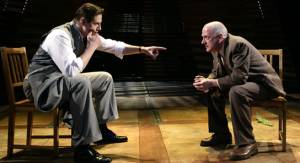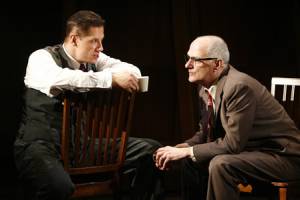RECOMMENDED
Bill W. And Dr. Bob, Samuel Shem and Janet Surrey’s biodrama about the founders of AA, has been around L.A. for quite a while now. Its current incarnation at Theatre 68 is in fact its fifth Los Angeles run and follows its 2007 New York Times-reviewed off-Broadway premiere at New World Stages. Having finally gotten the chance to see this often very moving story of the men who, almost by accident, revolutionized the treatment of alcoholism and other addictions, I can understand its popularity and appeal. Despite certain structural drawbacks and its air of “disease movie of the week,” Bill W. And Dr. Bob is both educational and entertaining, and in the second act especially, emotionally powerful.
The play begins at a pair of meetings, one in 1955, one in 1939, where speakers Bill and Dr. Bob introduce themselves to their audiences in a way familiar even to those who have never set foot in a 12-step meeting, prompting immediate audience response.
Bill W: Hello, my name is Bill.
Audience: Hello Bill.
The scene soon shifts to 1930s New York where Bill Wilson, the son and grandson of alcoholics, is promising his wife Lois yet again that he will stop drinking … tomorrow. Meanwhile, in Akron, Ohio, Dr. Bob Smith’s wife Anne is escaping to another of her church meetings, leaving the good doctor home alone with a bottle of whiskey (pulled out from its hiding place under his chair) to keep him company.
It soon becomes clear how alcohol transforms these two decent men into monsters and their wives into victims. Bill even goes so far as to steal a week’s worth of his wife’s wages to buy booze.
What eventually leads to the 12 Steps of AA and other self-help groups begins as a combination of inspiration and accident.
Inspiration comes from Bill’s realization that his drinking is not a sin, but a disease whose cure is self-knowledge. “As long as I stay away from that first drink, I’m okay,” he tells a stranger in a bar, then proves his words true by taking that first drink. Clearly, knowledge of self is not enough to stop a drunk from slipping off the wagon.
Though some alcoholics may have been helped by their religious faith, this approach doesn’t work for a non-believer like Bill. Though a friend explains to him that “you don’t have to believe in God. You just have to admit that you’re not God,” for Bill it’s simply too late. “I’m gone,” he confesses resignedly.
A second inspiration occurs when Bill wakes up once again in a hospital bed only to feel the room grow light. Recalls Bill, “I was seized by something. A spirit blew right through me and I heard its words, ‘You are a free man.’” Later, following four months of sobriety, he tells Lois, “I’m going to start a chain reaction that’s going to reach everyone in the world.”
Meanwhile in Ohio, Dr. Bob is struggling with his own demons, and his fear that making a public admission of his drinking would destroy his career as a surgeon. Though wife Ann tells him “They already know,” Bob is not yet ready to confess his addiction nor is he able to seek help from a God he does not believe in.
Then comes the accident (or twist of fate) of Bill’s business trip to Akron, the outcome of which proves so ruinous that he finds himself pulled like a magnet towards a bar. Sensing that the only way to stop from taking that first drink would be to talk to another alcoholic, Bill phones a local preacher who puts him in touch with a drunk and incoherent Dr. Bob. “It’s not about willpower,” Bill tells the doctor when they meet face to face. Only drunks can help other drunks, he explains, and it’s not just Dr. Bob who will be helped. “You need another drunk to talk to you as much as he needs you,” explains Bill in what is essentially the first AA meeting attended by its first two members.
These are of course only the seeds of AA, and Act 2 shows the two men reaching out to help others, and discovering in the process the truths that became the 12 Steps, beginning with an admission that one is powerless in the face of one’s addiction and including the need to make amends to those harmed by this addiction.
Director Ronnie Marmo has directed all five L.A. productions of Bill W. And Dr. Bob, and here he assumes the former role charismatically, with Michael Chieffo doing equally fine work as the troubled Dr. Bob. Andrea Birkman and Deborah Geffner are heartbreakingly real as their long-suffering wives. Paul Rogan and Barbara Keegan play all the other characters, from drunks to church people to wives of alcoholics, and flawlessly so.
If there’s anything that gets in the way of Bill W. And Dr. Bob attaining its full force as a play, it is its movie screenplay-like construction. Shem and Surrey have divided the drama into 24 scenes (including its prologue and epilogue), and this means 22 blackouts and scene changes. While this type of construction lends itself perfectly to film, on stage each blackout slows down the action, thereby reducing the play’s power and momentum.
Danny Cistone’s inventive set design does its best to keep scene change length to a minimum (e.g. the top half of a wall swings away to become a hotel lobby desk or bar counter) and his lighting design (while a bit too dim at times) focuses audience attention and enhances mood. Wendy Marmo’s music supervision and Bruce Barker’s sound design set the play squarely in the 1930s as does Neda Pourang’s excellent choice of 1930s wardrobe.
While Bill W. and Dr. Bob’s greatest allure may be to those able to emphasize with the two men’s struggles, it also succeeds in informing and educating those who know little about the birth of 12 Step programs. Though perhaps better suited to film than stage, Shem and Surrey’s play is a well-deserved tribute to two “unknown” men who transformed the lives of people battling addictions the world over. It is definitely worth a look-see.
Theatre 68, 5419 Santa Monica Blvd., Suite D. Hollywood.
www.plays411.com/billw
–Steven Stanley
January 4, 2009
Photo is from Off-Broadway production




 Since 2007, Steven Stanley's StageSceneLA.com has spotlighted the best in Southern California theater via reviews, interviews, and its annual StageSceneLA Scenies.
Since 2007, Steven Stanley's StageSceneLA.com has spotlighted the best in Southern California theater via reviews, interviews, and its annual StageSceneLA Scenies.







 COPYRIGHT 2024 STEVEN STANLEY :: DESIGN BY
COPYRIGHT 2024 STEVEN STANLEY :: DESIGN BY